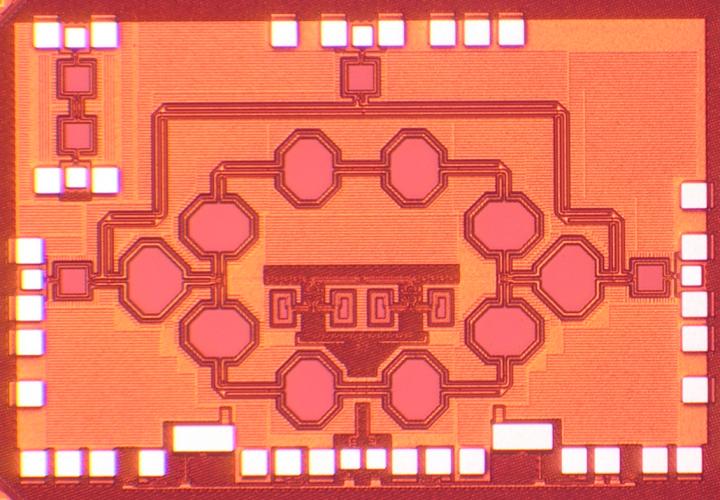
Columbia Engineers Develop Advanced Millimeter-Wave Circulator IC

This is a chip microphotograph of the 25GHz fully-integrated non-reciprocal passive magnetic-free 45nm SOI CMOS circulator based on spatio-temporal conductivity modulation.
Credit: Tolga Dinc/Columbia Engineering
Columbia Engineering researchers, led by Harish Krishnaswamy, associate professor of electrical engineering, in collaboration with Professor Andrea Alu's group from UT-Austin, continue to break new ground in developing magnet-free non-reciprocal components in modern semiconductor processes.
At the IEEE International Solid-State Circuits Conference in February, Krishnaswamy's group unveiled a new device: the first magnet-free non-reciprocal circulator on a silicon chip that operates at millimeter-wave frequencies (frequencies near and above 30GHz). Following up on this work, in a paper (DOI 10.1038/s41467-017-00798-9) published today in Nature Communications, the team demonstrated the physical principles behind the new device. VIDEO: https:/
Most devices are reciprocal: signals travel in the same manner in forward and reverse directions. Nonreciprocal devices, such as circulators, on the other hand, allow forward and reverse signals to traverse different paths and therefore be separated. Traditionally, nonreciprocal devices have been built from special magnetic materials that make them bulky, expensive, and not suitable for consumer wireless electronics.
The team has developed a new way to enable nonreciprocal transmission of waves: using carefully synchronized high-speed transistor switches that route forward and reverse waves differently. In effect, it is similar to two trains approaching each other at super-high speeds that are detoured at the last moment so that they do not collide.
The key advance of this new approach is that it enables circulators to be built in conventional semiconductor chips and operate at millimeter-wave frequencies, enabling full-duplex or two-way wireless. Virtually all electronic devices currently operate in half-duplex mode at lower radio-frequencies (below 6GHz), and consequently, we are rapidly running out of bandwidth.
Full-duplex communications, in which a transmitter and a receiver of a transceiver operate simultaneously on the same frequency channel, enables doubling of data capacity within existing bandwidth. Going to the higher mm-wave frequencies, 30GHz and above, opens up new bandwidth that is not currently in use.
“This gives us a lot more real estate,” notes Krishnaswamy, whose Columbia High-Speed and Mm-wave IC (CoSMIC) Lab has been working on silicon radio chips for full duplex communications for several years. His method enables loss-free, compact, and extremely broadband non-reciprocal behavior, theoretically from DC to daylight, that can be used to build a wide range of non-reciprocal components such as isolators, gyrators, and circulators.
“This mm-wave circulator enables mm-wave wireless full-duplex communications, Krishnaswamy adds, “and this could revolutionize emerging 5G cellular networks, wireless links for virtual reality, and automotive radar.”
The implications are enormous. Self-driving cars, for instance, require low-cost fully-integrated millimeter-wave radars. These radars inherently need to be full-duplex, and would work alongside ultra-sound and camera-based sensors in self-driving cars because they can work in all weather conditions and during both night and day. The Columbia Engineering circulator could also be used to build millimeter-wave full-duplex wireless links for VR headsets, which currently rely on a wired connection or tether to the computing device.
“For a smooth wireless VR experience, a huge amount of data has to be sent back and forth between the computer and the headset requiring low-latency bi-directional communication,” says Krishnaswamy. “A mm-wave full-duplex transceiver enabled by our CMOS circulator could be a promising solution as it has the potential to deliver high speed data with low latency, in a small size with low cost.”
The team, funded by sources including the National Science Foundation EFRI program, the DARPA SPAR program, and Texas Instruments, is currently working to improve the linearity and isolation performance of their circulator. Their long-term goal is to build a large-scale mm-wave full-duplex phased array system that uses their circulator.
###
About the Study
The study is titled, “Synchronized Conductivity Modulation to Realize Broadband Lossless Magnetic-Free Non-Reciprocity.” The other contributors are Tolga Dinc and Aravind Nagulu (Department of Electrical Engineering, Columbia Engineering), and Mykhailo Tymchenko, Dimitrios Sounas, and Andrea Alu (Department of Electrical & Computer Engineering, The University of Texas at Austin).
The study was supported by grants from the DARPA ACT (grant #FA8650-14-1-7414) and SPAR (grant #HR0011-17-2-0007) programs and by the National Science Foundation EFRI program (grant #1343282).
The authors declare no financial or other conflicts of interest.
LINKS:
PAPER: DOI 10.1038/s41467-017-00798-9
VIDEO: https:/
http://www.
http://www.
http://www.
Columbia Engineering
Columbia Engineering is one of the top engineering schools in the U.S. and one of the oldest in the nation. Based in New York City, the School offers programs to both undergraduate and graduate students who undertake a course of study leading to the bachelor's, master's, or doctoral degree in engineering and applied science. Columbia Engineering's nine departments offer 16 majors and more than 30 minors in engineering and the liberal arts, including an interdisciplinary minor in entrepreneurship with Columbia Business School. With facilities specifically designed and equipped to meet the laboratory and research needs of faculty and students, Columbia Engineering is home to a broad array of basic and advanced research initiatives, from the Columbia Nano Initiative to the Columbia Genome Center. These interdisciplinary centers in science and engineering, big data, nanoscience, and genomic research are leading the way in their respective fields while our engineers and scientists collaborate across the University to solve theoretical and practical problems in many other significant areas.












